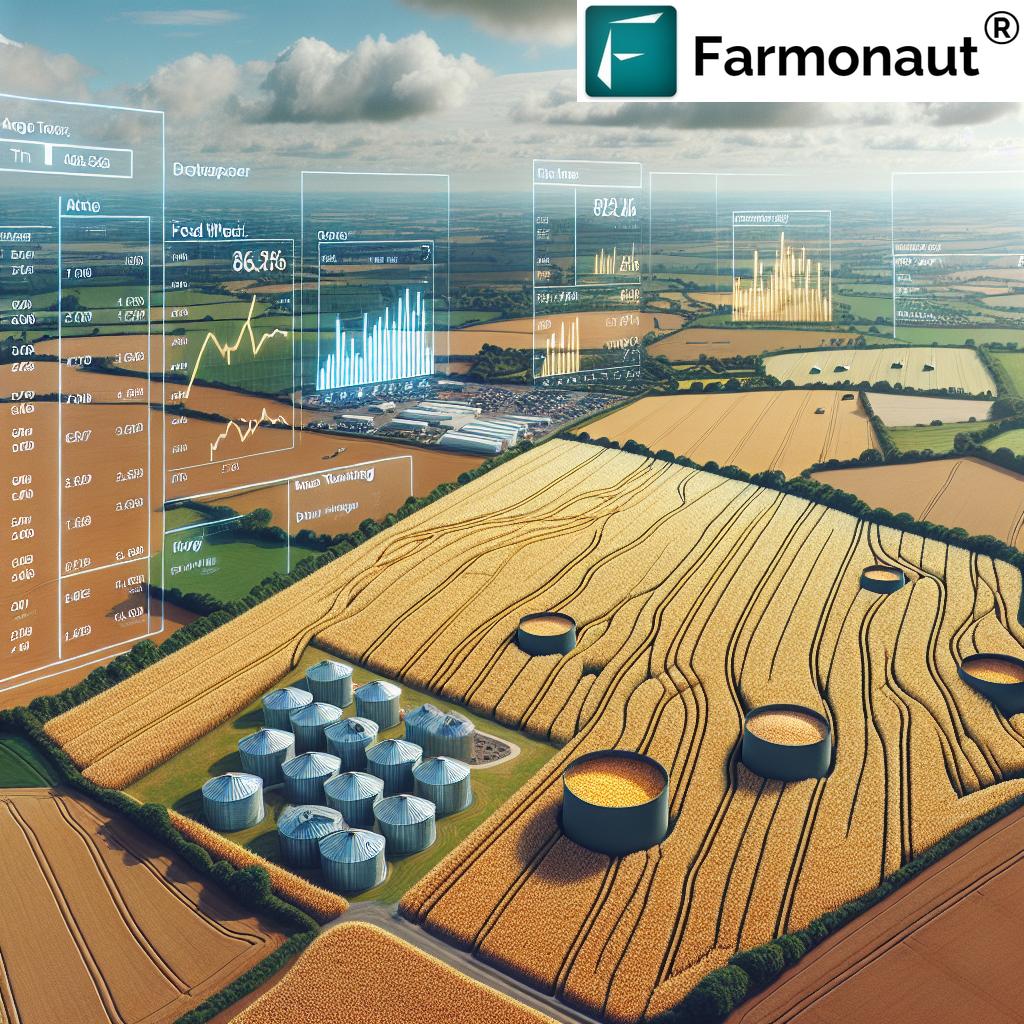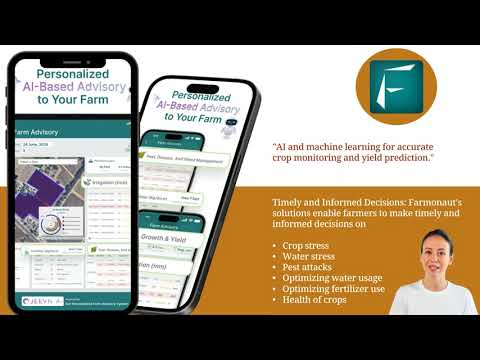Wheat Market Prices: Latest UK & European Crop Trends 2024
Table of Contents
- Introduction
- Trivia
- Wheat Market Prices: 2024 Overview
- Major Market Drivers
- UK & European Wheat Price Trends
- European Rapeseed Market Overview
- Rapeseed Import Trends in the EU
- Impact of Weather and Currency Fluctuations
- Global Grain Market Trends and Export Forecasts
- How Farmonaut Supports Precision Agriculture
- Comparative Market Price Trends Table
- Farmonaut: Real-Time Crop Monitoring for 2024’s Volatile Markets
- FAQ – Wheat, Rapeseed & Market Insights 2024
- Farmonaut Subscription Plans
- Conclusion
“UK wheat prices rose 8% in early 2024, driven by weather disruptions and shifting European export forecasts.”
As we progress deeper into 2024, the wheat market prices and the European rapeseed market are capturing attention not only in the United Kingdom but across the continent and globally. Ongoing macroeconomic shifts, weather volatility, and dynamic export demands are driving significant change in global grain market trends. For farmers, agribusinesses, commodity analysts, and policy makers, understanding what’s behind current crop price movements is essential for effective decision making.
In this comprehensive industry report, we analyze the latest UK feed wheat futures, dissect European rapeseed market signals, and interpret the effects of weather, currency fluctuations, import, and export forecasts—from the US maize belt planting delays to Ukraine’s wheat export pricing strategies. These insights are brought to you by Farmonaut, a leading provider of advanced satellite-based farm management and crop monitoring.
Wheat Market Prices: 2024 Overview
The turbulence in wheat market prices across the UK and Europe is a result of both domestic pressures and global influences. With UK feed wheat futures (May-25) managing to recover above the 20-day rolling average, and the relative strength index showing a slight market uptick, market participants are increasingly looking at key drivers such as weather updates, export demands, and macrocurrency movements.
Similarly, the European rapeseed market has been energized by supply changes, robust import activity, and developments in the wider vegetable oil complex (soya oil, canola), as well as the global crude oil price forecast.
Why Monitor Wheat and Rapeseed Market Prices?
For farmers and stakeholders, timely awareness of wheat market prices and European rapeseed market indicators allows us to:
- Optimize sales strategies based on support/resistance price levels
- Plan procurement and input purchases ahead of spring crop planting conditions
- Minimize risks associated with volatile currency and export flows
- Stay informed on potential weather disruptions affecting crops in major producing regions, such as the US maize belt and Ukraine
- Leverage advanced crop monitoring platforms such as Farmonaut for real-time decision-support
Major Market Drivers Affecting 2024 Crop Prices
Last week, the old crop UK feed wheat futures (May-25) fell by £0.60/t to close at £172.95/t from Friday to Thursday. Meanwhile, the new crop contract (Nov-25) gained £0.15/t, ending at £186.90/t, widening its premium over the old crop. This divergence underscores the influence of several key market drivers:
- Bearish Sentiments in the wider grains market, particularly for old crop
- Export Flows: Weak export demand and currency strength (a strengthening euro against the US dollar suppressing European exports)
- Weather Updates: Concerns about dryness in critical regions impact winter wheat and spring crop planting
- Russia/Ukraine: Peace negotiations impact wheat export prices Ukraine and global sentiment
- Crop Progress: Updates from agencies such as FranceAgriMer and USDA keep crop health and plantings in focus
UK & European Wheat Price Trends: Support, Resistance, and Market Momentum
The interplay between supply, demand, and speculative trading activity is clearly visible in wheat market prices. Here’s how local and continental forces are shaping trends:
UK Feed Wheat Futures
- Old crop (May-25) briefly dipped below support but regained strength above the 20-day moving average
- Relative strength index (RSI) points to climbing market momentum, though still within a defined range
- New crop (Nov-25) maintains a notable premium, driven by increased uncertainty around upcoming harvest conditions and input costs
Snapshot: International Wheat Markets
- Chicago wheat (May-25): Down 1.3% from Friday to Thursday as weather changes and US export outlook put pressure on futures
- Paris milling wheat (May-25): Down 3.2% week-on-week, partly due to a stronger euro and overseas competition
It’s essential to assess how shifts in currency (euro vs. dollar), local weather, and global trade disputes combine to either cap or catalyze price growth—especially in the tight band around old vs new crop.
Comparative Market Price Trends Table: UK & Major European Crops (2024)
| Region/Country | Wheat Price (€/t or £/t) |
Rapeseed Price (€/t) |
2024 Trend vs 2023 | Key Driving Factors |
|---|---|---|---|---|
| UK | £172.95 (May-25) | €479.50 (Nov-25) | +8% (Wheat), +7% (Rapeseed) | Weather, export/demand, currency, local stocks |
| France | €236 (May-25, Milling Wheat) | €535 (May-25) | +6% (Wheat), +9% (Rapeseed) | Improved crop conditions, high import demand |
| Germany | €225 (Estimate, May-25) | €550 (Resistance) | +4% (Wheat), +10% (Rapeseed) | Soil moisture deficits, robust oil demand |
| Poland | €215 (Estimate, May-25) | €498 (Estimate, May-25) | +3% (Wheat), +5% (Rapeseed) | Dryness, low stocks, import competition |
| Ukraine | $215 (Estimate, Export) | N/A | -15% (Wheat) | War, peace talks, export volumes |
| Canada | N/A | NA | NA | Canola stocks lowered, export surge |
“European rapeseed market saw a 5-year high in March 2024, reflecting global grain supply uncertainties.”
European Rapeseed Market: Record Highs, Imports, and Oil Price Ripple Effects
The European rapeseed market is demonstrating resilience and growth, buoyed by high demand amid constrained supply. Notably, May-25 Paris rapeseed futures have found resistance at €550/t, with the old crop closing at €535.00/t—up €12.50/t, and the new crop (Nov-25) gaining €3.50/t to €479.50/t. The premium for old crop rapeseed now extends to €55.50/t, highlighting tight supply-versus-demand dynamics.
Key forces driving this robust rapeseed price environment:
- Vegetable Oil Complex Growth: Paris rapeseed is tracing the strength of soya oil and Canadian canola, alongside surging crude oil prices.
- Lower Soya Oil Stocks: According to the National Oilseed Processors Association (NOPA), soya oil stocks dropped by 0.3% to 1.671 billion lbs at March-end, 19.1% lower than last year.
- Canadian Canola Exports: Season-to-date canola stocks Canada are falling, as exports reach 7.4 Mt with several weeks left in the marketing year. Total 2024/25 canola exports are forecast at 8.3 Mt (USDA).
- EU Import Demand: With a reduced local crop, rapeseed import trends EU show that imports have reached 5.3 Mt by mid-April, up from 4.6 Mt last year.
- Production Forecasts and Area: The French Farm Ministry raised 2025 rapeseed area to 1.29 Mha.
Rapeseed Import Trends EU: Navigating Tight Supplies
Rapeseed import trends EU have shifted upwards, with the EU Commission reporting 5.3 Mt of imports from July 2023 to April 2024. Strong demand and reduced domestic output have compelled market participants to seek alternative origins in Canada, Ukraine, and Australia.
As a result, import competition is fierce—not just for rapeseed, but across the vegetable oil price forecast spectrum, further driving spot and futures markets.
Weather, Currency Fluctuations & Spring Crop Planting Conditions
Weather remains at the center of our attention as it directly influences both crop conditions and price behavior in the UK, France, Germany, Poland, and beyond.
- Dryness in the US set the stage for earlier wheat concerns, but recent rains have provided modest relief and shifted focus to delayed US maize belt planting.
- USDA Crop Ratings: 45% of US winter wheat crop rated good or excellent as of last reporting, down from 50% last year.
- FranceAgriMer: 75% of France’s wheat crop in good/excellent condition (by April 14), compared to 64% last year.
- European Soil Moisture: LSEG notes persistently low soil moisture in Poland and Germany, risking spring and summer crop development.
- Spring Maize Plantings: France has planted 39% of its maize by April 14, up sharply from last week—suggesting rapid catch-up if weather holds.
- Currency Movements: The euro has strengthened against the US dollar, compounding export competitiveness struggles for European grains and supporting input cost inflation.
Global Grain Market Trends & Export Forecasts
It is vital to contextualize wheat market prices and market moves within global supply/demand balance and trade flows. Export forecasts remain volatile as the North American spring unfolds and the Eastern European geopolitical situation evolves.
Key Global Market Highlights:
- Wheat Export Prices Ukraine: Sovecon analysts noted that optimism over Russia-Ukraine peace talks led to lower Russian export prices; April Russian exports are forecast at 2.0 Mt (significantly down from 5.0 Mt April 2024).
- Ukraine 2025 Rapeseed Crop: Expected to fall to 3.39 Mt (vs. 3.8 Mt USDA, down from 3.7 Mt in 2024). Exports likely dropping to 2.72 Mt from 3.14 Mt.
- Sunflower Seed Outlook: Ukrainian 2025 sunflower harvest, on the other hand, is projected to rise 14% to 15.2 Mt—affecting oil complex supply and pricing trends.
- Canadian Canola Exports: Despite trade tensions, robust demand keeps canola stocks Canada low, adding further support to global oilseed values.
European Union Crop Outlook & Production Forecasts
- EU rapeseed production estimate (EU-27 + UK) for marketing year 2025/26 is unchanged at 19.9 Mt (LSEG), with localized dryness posing a risk to key contributors (notably Poland and Germany).
- Farmers, cooperatives, and agribusinesses must remain vigilant to sudden shifts in weather patterns and geopolitical trade events, and react nimbly using real-time tools.
How Farmonaut Supports Precision Agriculture in Volatile Markets
With crop markets as volatile as in 2024, the need for accurate, timely information is critical. At Farmonaut, we empower farmers, agribusinesses, and government institutions worldwide to monitor crop conditions and manage risk effectively:
- Satellite-Based Crop Health Monitoring: Our tools deliver up-to-date NDVI, soil moisture, and weather indices, helping users spot disease, drought, or nutrient issues—enabling smarter irrigation and input planning.
- APIs for Developers: Integrate satellite, weather, and crop imagery directly into in-house systems. See full API Developer Documentation.
- Jeevn AI Advisory System: Provides field-specific insights, input advice, and weather forecast integration to maximize productivity under changing market and production conditions.
- Blockchain-Based Product Traceability: Secure supply chains with agri-traceability solutions—protecting against fraud and ensuring consumer trust.
- Fleet and Resource Management: For large-scale agribusinesses, streamline your logistics with fleet management tools, reducing operational costs.
- Carbon Footprint Monitoring: For sustainable farming and compliance, our carbon footprint tracking helps you monitor and reduce emissions efficiently.
- Satellite-based Crop Loan and Insurance Verification: Banks and insurers use our solutions for fraud reduction and improved access to finance.
- Large-Scale Farm Management Platform: Government bodies and agro-enterprises can leverage our scalable, admin-driven satellite monitoring solutions for yield estimation, policy making, and subsidy oversight.
Farmonaut: Real-Time Crop Monitoring for 2024’s Volatile Markets
Real-time satellite technology is no longer a luxury—it’s a necessity in fast-moving agricultural markets. Here’s how our platform is designed for today’s climate:
- Affordable Precision Agriculture: Monitor more hectares at a lower cost. Farmonaut’s modular subscription model is accessible via web, android, iOS and browser app.
- AI-Driven Advisory: From spring crop planting conditions to harvest risk assessment, our Jeevn AI engine delivers practical insights.
- Blockchain Traceability: Meet customer and regulator demand for transparency in agri-supply chains.
- Scalable Solutions: Whether smallholder or large cooperative, configure the platform to your operational scale.
- Resource Sustainability: Plan for the future by tracking water, inputs, and carbon emissions with seamless, automated reporting.
Try Farmonaut’s satellite-powered crop health and market insight tools today →
FAQ – Wheat, Rapeseed & Market Insights 2024
-
What are the main factors influencing UK wheat market prices in 2024?
UK wheat market prices are shaped by changing weather conditions, export demand, currency fluctuations (especially euro/dollar), and speculative activity. New crop development and international events—such as the conflict in Ukraine and US maize belt planting delays—also play a pivotal role.
-
Why did the European rapeseed market hit a five-year high?
The European rapeseed market reached its highest point in five years due to strong demand, tight EU/UK supply, increased imports, rallying vegetable oil prices, and risk of production cuts from drought and reduced planting areas.
-
How do US and global weather events impact our crops and market prices?
Adverse weather, such as dryness in key US wheat states or delays in US maize belt planting, can reduce yield prospects and impact global grain market trends. Real-time monitoring mitigates risk by allowing timely reactions to evolving conditions.
-
What is Farmonaut and how does it help manage market volatility?
Farmonaut provides technology-driven, real-time crop health monitoring, AI-based advisories, blockchain traceability, and resource management tools—enabling users to make informed decisions, reduce input costs, and increase yield stability in volatile markets.
-
How do I start using Farmonaut’s services?
Download the Farmonaut app from the Google Play Store or App Store, or access the web app directly. Developers and businesses can utilize our APIs for larger integration.
-
Is Farmonaut suitable for smallholder farmers as well as large enterprises?
Yes, Farmonaut’s platform is scalable and modular, catering to the needs of small and large farms, agribusinesses, governments, and corporate clients.
-
How can I use Farmonaut for sustainable farming?
The platform supports sustainability by offering carbon footprint tracking, soil moisture monitoring, and efficient resource planning in real time.
Farmonaut Subscription Plans
Unlock more from your farming operations or agribusiness by subscribing to Farmonaut’s precision agriculture tools. Explore affordable, flexible plans for real-time crop health monitoring, custom AI advisory, satellite imagery, and more:
Conclusion: Stay Ahead of Market Shifts
2024 has already proven to be a dynamic year for the wheat market and the European crop sector at large. Wheat market prices, rapeseed values, and global grain market trends are at the mercy of rapid weather changes, shifting export landscapes, and evolving consumer demand. As these forces continue to shape market movements, informed decision-making and the use of real-time data will be critical.
Farmonaut’s mission is to make precision agriculture affordable and accessible. Our satellite-based platform delivers actionable intelligence to help navigate uncertainty, reduce risk, and improve both yields and sustainability. Embrace the future of agriculture—leverage Farmonaut for the insights you need to thrive in today’s fast-evolving market landscape.
Explore Farmonaut’s technology today for data-driven, informed, and sustainable agriculture: Start Here








